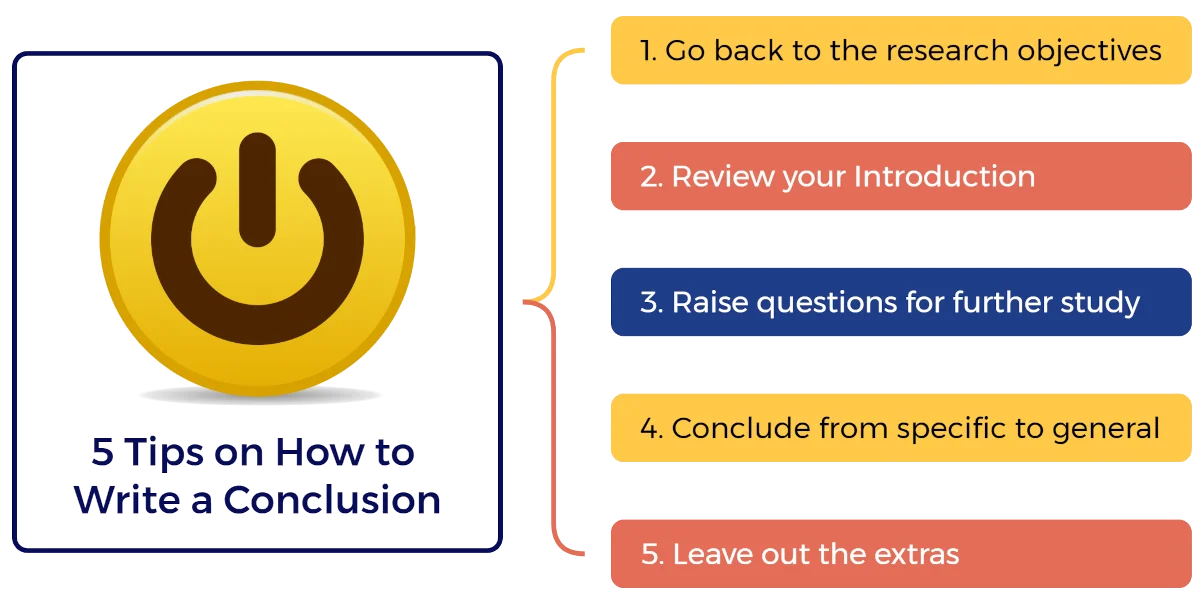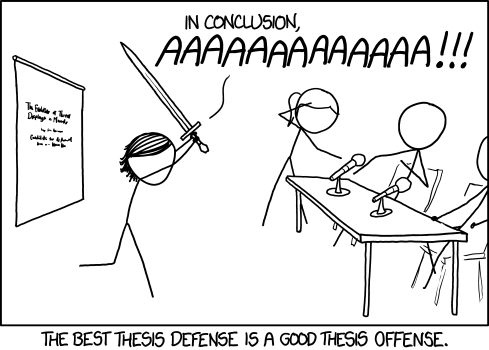Updated | September 22, 2025

The conclusion is an integral part of a research paper or thesis. Writing a proper conclusion, therefore, should not be taken for granted. It wraps up the major findings of a scientific investigation and serves as a springboard for future studies.
How should this essential part of a research paper be written? What good practices can you adopt for effectively writing it up?
This article provides five tips on how to write a conclusion with examples for greater clarity.
Table of Contents
How to Write a Conclusion Paragraph: 5 Tips
1. Go back to the objectives of your research
To be systematic about it, re-read the objectives of your study or the statement of the research problems. Write something about objective number 1, number 2, and so on.
After going through all those methods to answer the objectives or the statement of your problem, write your synthesis of findings in a sentence or two. The idea is to write the conclusion concisely without leaving out the important elements.
Consider this simplified example of a research objective and the resulting conclusion:
Objective #1. Determine the relationship between time spent by teenagers on social networking sites and time spent with friends offline.
Conclusion: There is a reason to believe that time spent on social networking sites reduces teenagers’ opportunities to spend time with friends offline.
That is the meat of your conclusion. You can build on that statement and offer ideas so that other researchers can investigate further on the issues you have raised.
You may ask yourself the following question:
“So what if the time spent by teenagers on social networking sites reduce their time spent with friends online?”
You might say that this is an important finding that parents and educators must look into to prevent teenagers from becoming socially handicapped adults. This weakness could lead to an inability to work harmoniously with other people.

2. Review your introduction
Make sure that your conclusion addresses the issue or gap that you have identified while exploring the research subject in the introduction of your research paper.
Have you resolved the issues that you have raised or did your investigation lead to more questions?
Your conclusion should wrap up the whole paper. It is here where you integrate all your findings.
Integration means putting all the ideas together to come up with a general idea. That general idea may become a theory in the long run; that is, if future studies converge towards or support what you are proposing as an explanation for a phenomenon. In other words, this is where you once again present your thesis.
For example, using the study on time spent by teenagers online, your introduction may have pointed out that many of the recent graduates are socially handicapped employees. So this could be traced to their habits as “screenagers” or teenagers who spent most of their time in front of the computer in the past.

3. Raise questions for further study
Not all research results are conclusive. It is possible that the data you have gathered is not enough to draw out a sound conclusion that can help explain the issue you are looking into. There may be things that need to be added, considered, or factored in to shed better light on an unexplained phenomenon.
You can point this out in the conclusion and offer a course of action that future researchers can take. This will help researchers investigating a similar issue to use your paper as one foundation for another study. Your research will help unravel the mysteries of a phenomenon that baffle contemporary scientists.
For example, a medical researcher may have found evidence that immunotherapy works better than all other conventional treatments to cancer. But the samples are quite small such that the efficacy of such treatment could not be established for the general population. It is possible that immunotherapy works for only a certain group of people, but not for everyone.
4. Conclude from specific to general
Writing the conclusion follows an inductive approach in most scientific research. This means that you write it from specific to general. You have broken down the problem into manageable bits during the analysis. Now, in writing the conclusion, you build from the pieces once again to come up with a broad picture.
Going back through the process by which you conduct research, the inductive approach works this way your research:
- you gathered evidence using a systematic approach,
- you analyzed your data to discover patterns, relationships, or discrepancies, and
- you came up with a hypothesis or theory to explain what you have observed.
In reality, the conclusion that you came up with using the inductive approach does not guarantee it as an absolute truth. It is always subject to fallibility. That is because you cannot account for all the possibilities that things will occur predictably. There is always the possibility of error.
That is why it is always safe to say statements like:
Based on the data gathered in this study, there is reason to believe that… (whatever your conclusion is).
Or
The data presents sufficient evidence that… (another conclusion).
The important thing you need to remember on how to write a conclusion is that you are able to share something useful in the body of literature based on your incisive analysis and interpretation of the patterns, discrepancies, or deviations revealed by your data.
You synthesize things and come up with a statement or two that answers or fulfills the research objectives set in the introductory part of the study.
5. Leave out the extras
The conclusion should be without unnecessary statements that destroy the objectivity of the conclusion. Avoid statements that are:
- sentimental
- afterthoughts
- phrases that state the obvious such as “In conclusion,” “Summing it all up,” etc.
- unnecessary statistics, and
- quotations.
Give yourself ample time to practice these tips on how to write a conclusion. Writing a good conclusion is a thesis writing skill that needs to be honed.
How to Start a Conclusion Paragraph
Beginning your conclusion paragraph requires clarity and a sense of closure. The first sentences should signal to the reader that you are wrapping up your discussion while staying connected to your objectives and findings.
Here are some good practices:
1. Restate your research objectives or problem. This creates a direct link between your introduction and conclusion. Instead of copying your statement word-for-word, rephrase it concisely.
- Example: This study set out to explore the relationship between study habits and academic performance among senior high school students.
2. Summarize the key findings in one or two sentences. Start from the most important result and move toward supporting evidence.
- Example: The findings show that consistent time management and self-regulated learning strategies contribute significantly to higher academic performance.
3. Connect back to the bigger picture. Briefly remind the reader why your study matters, either in theory, practice, or policy.
- Example: These insights highlight the importance of developing academic programs that foster independent learning skills.
A strong beginning to your conclusion sets the stage for integration, implications, and recommendations, making it easier to transition smoothly into the rest of your closing discussion.
Complete Conclusion Examples Across Disciplines Based on These Tips
Here are sample conclusion statements across different fields, modeled after actual research writing. Each one demonstrates how to close a study clearly and effectively.
1. Education (Online Learning)
This study demonstrates that blended learning approaches enhance student engagement more effectively than purely online or face-to-face classes. These results suggest that educators should design hybrid models that balance flexibility with structured interaction. Future investigations may focus on how such models affect long-term retention and skill development.
2. Environmental Science (Water Quality Monitoring)
The results reveal that heavy metal concentrations in the river system exceeded safe limits in three monitoring stations, indicating potential risks to aquatic life and nearby communities. These findings emphasize the urgent need for stricter enforcement of environmental regulations and community-based monitoring programs. Additional studies could assess seasonal variations in contamination levels.
3. Public Health (Nutrition and Lifestyle)
Evidence from this study supports the claim that adherence to a plant-based diet lowers cholesterol levels among middle-aged adults. While the data are promising, the limited sample size warrants larger clinical trials. Policymakers may use these insights to promote healthier dietary guidelines and preventive interventions.
4. Information Technology (Cybersecurity in Small Businesses)
The investigation shows that small enterprises adopting cloud-based security frameworks reduced data breach incidents by 30% over a one-year period. This highlights the cost-effectiveness of integrating advanced security tools even in resource-limited settings. Future studies may examine scalability and adaptability across different industries.
5. Business and Management (Remote Work Productivity)
Findings from this research indicate that remote work arrangements improve employee productivity when supported by effective digital collaboration tools and clear communication policies. These results have practical implications for organizations redesigning workplace policies in the post-pandemic era. Longitudinal studies may further clarify the long-term effects on organizational culture and employee well-being.
References
Literacy Education Online (n.d.) Strategies for writing a conclusion. Retrieved on May 30, 2015 from http://leo.stcloudstate.edu/acadwrite/conclude.html 2004.
The Writing Center, University of North Carolina at Chapel Hill (n.d.). Conclusions. Retrieved on May 30, 2015 from http://writingcenter.unc.edu/handouts/conclusions/
FAQ How to Write a Conclusion
Q1. Why is the conclusion important in a research paper or thesis?
The conclusion summarizes the key findings of a study and shows how they relate to the research objectives. It also provides closure to the discussion and may suggest directions for future research.
Q2. How should I start writing a conclusion paragraph?
Begin by restating your research objectives or problem, then summarize the most important findings in one or two sentences. Finally, connect your results to the bigger picture, such as implications for practice, theory, or policy.
Q3. What are some tips for writing an effective conclusion?
Go back to your research objectives and address them clearly.
- Review your introduction and show how the study resolved the issues raised.
- Raise questions for further study if findings are not conclusive.
- Move from specific findings to general insights.
- Avoid unnecessary phrases, statistics, or sentimental statements.
Q4. What should I avoid when writing a conclusion?
Avoid clichés like “In conclusion,” unnecessary quotations, redundant statistics, and personal afterthoughts that weaken objectivity.
Q5. Can I suggest future research in my conclusion?
Yes. If your results are limited or inconclusive, you can recommend directions for future research. This helps other researchers build upon your work.


